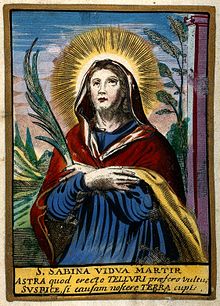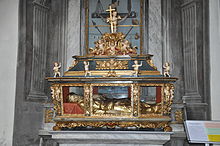| Saint Sabina | |
|---|---|
 Saint Sabina of Rome Saint Sabina of Rome | |
| Martyr | |
| Born | 1st century AD Rome |
| Died | c. 119 to 126 AD Rome |
| Venerated in | Catholic Church Eastern Orthodox Church |
| Canonized | Pre-Congregation |
| Major shrine | Santa Sabina on the Aventine Hill, Rome |
| Feast | 29 August |
| Attributes | book, palm and crown |
Saint Sabina is a saint of the early church, believed to have lived and suffered martyrdom at the beginning of the 2nd century in Rome. Her feast day is 29 August.
Narrative

Sabina was the daughter of Herod Metallarius and the wealthy widow of Senator Valentinus, originally from Avezzano in the Abruzzo region of Italy.
Sabina converted to Christianity due to the example of her Syrian slave Serapia. The widow then withdrew with a few devout friends to one of her country seats, where she spent her time doing good works. Serapia was denounced and beheaded in the city of Vindena in the state of Umbria. Sabina rescued her remains and had them interred in the family mausoleum where she also expected to be buried. Sabina was later denounced as well, and accused of being a Christian by Elpidio the Prefect. She was thereupon martyred in Rome c. 126 AD.
In 430 her relics were brought to the Aventine Hill, to the newly erected basilica Santa Sabina on the site of her house, originally situated near a temple of Juno. This house may also have formed an early Christian titular church. The church was initially dedicated to both Sabina and Serapia.
Commentary
According to Klemens Löffler, writing for the Catholic Encyclopedia, the Acts of the martyrdom have no historic value. Maya Maskarinec suggests that "'Sabina'...was most plausibly the donor who had provided the titulus with property on the Aventine." Often this was a private home to be used as a church. When someone donated property or money, the resulting foundation bore their name. The passio that developed during the sixth to eighth century becomes attached to the memory regarding a late fourth or early fifth century philanthropist. "Gradually, however, throughout Rome, many of the tituli's donors metamorphosed into their communities' patron saints."
References
- "St. Sabine", Vatican News
- "History of St. Sabina and St. Sabina Church".
- "St. Sabina, Martyr, at Rome", Antiochian Orthodox Christian Archdiocese
- Roth, Leland M. (1993). Understanding Architecture: Its Elements, History and Meaning (First ed.). Boulder, CO: Westview Press. pp. 245. ISBN 978-0-06-430158-9.
- ^ Löffler, Klemens. "St. Sabina." The Catholic Encyclopedia Vol. 13. New York: Robert Appleton Company, 1912. 3 December 2021
 This article incorporates text from this source, which is in the public domain.
This article incorporates text from this source, which is in the public domain.
- ^ Maskarinec, Maya. City of Saints: Rebuilding Rome in the Early Middle Ages University of Pennsylvania Press, 2018, p. 105 ISBN 9780812250084
External links
- "Saint Sabina, The Woman". Saint Sabina Parish. Archived from the original on 2014-10-17. Retrieved 2014-12-01.